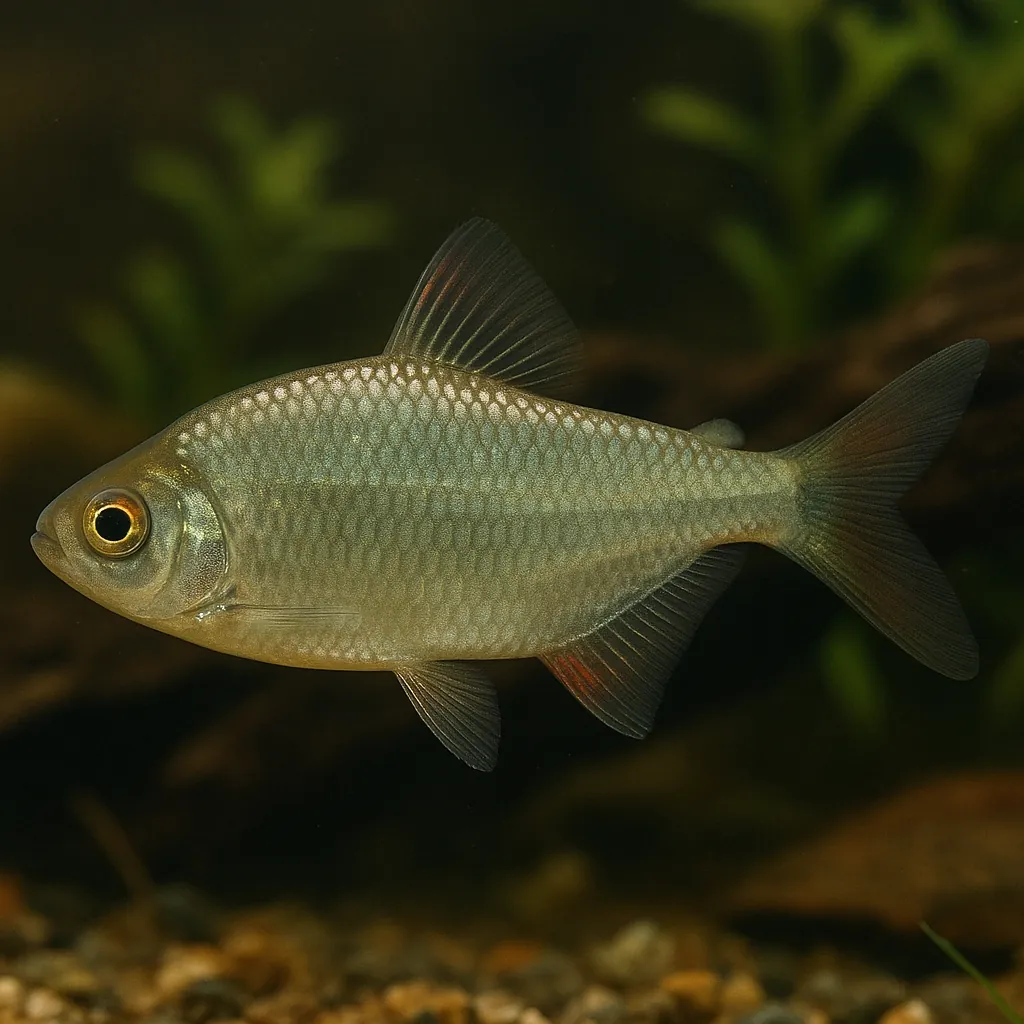
African moon tetra
Introduction
The African moon tetra (Bathyaethiops caudomaculatus) is a captivating freshwater fish native to the Congo River Basin in Central Africa. Renowned for its shimmering silver body adorned with a distinctive black spot near the tail, this species adds a touch of elegance to any aquarium. Its peaceful nature and manageable care requirements make it an excellent choice for both novice and intermediate fishkeepers.
What makes the African moon tetra a popular choice among aquarists?
Its striking appearance combined with a calm demeanor allows it to coexist harmoniously with various tank mates, enhancing the visual appeal of community aquariums.
Is the African moon tetra suitable for beginners?
Yes, with proper care and attention to its environmental needs, this species is well-suited for those new to fishkeeping.
Care and Environment
Providing optimal care for the African moon tetra involves replicating its natural habitat and maintaining stable water conditions.
What is the minimum tank size for an African moon tetra?
A minimum of 75 liters (20 gallons) is recommended to accommodate a small group, as they thrive in shoals.
What are the ideal water parameters for this species?
Maintain a temperature between 22-26°C (71.6-78.8°F), pH levels of 6.4-7.0, and water hardness ranging from 5-15°dH.
How should the tank be set up to mimic their natural environment?
Incorporate dense vegetation, a dark substrate, and moderate lighting. Adding leaf litter can create a blackwater effect, providing additional cover and mimicking their native habitat.
Filtration should be efficient to maintain water quality, as African moon tetras are sensitive to poor conditions. Regular water changes of 20-25% weekly are essential.
As omnivores, they accept a variety of foods. A staple diet of high-quality flake or small pellets should be supplemented with live or frozen foods like bloodworms or brine shrimp to enhance their health and coloration.
While generally peaceful, they may exhibit mild aggression during breeding. Ensuring ample space and hiding spots can help mitigate any territorial behavior.
Origin and Habitat
The African moon tetra is indigenous to the central and lower Congo River Basin, including regions in the Democratic Republic of Congo and Cameroon.
What type of environments do they inhabit in the wild?
They are typically found in slow-flowing rivers, densely vegetated streams, and backwaters with abundant underwater structures and floating plants.
How does their natural habitat influence their care in captivity?
Understanding their preference for calm, plant-rich waters helps aquarists design tanks that provide similar conditions, promoting their well-being.
Temperament and Compatibility
African moon tetras are peaceful, shoaling fish that thrive in groups of six or more.
What are suitable tank mates for African moon tetras?
Compatible companions include other small, non-aggressive species such as neon tetras, harlequin rasboras, and corydoras catfish.
Are there any fish species to avoid housing with them?
It's advisable to avoid larger or aggressive fish that may intimidate or outcompete them for food.
Providing ample swimming space and hiding spots ensures a harmonious community tank environment.
Interesting Facts
Beyond their beauty, African moon tetras possess intriguing traits that captivate aquarists.
What unique physical features do they have?
They exhibit a large black spot at the base of their forked caudal fin and a small red spot under the dorsal fin, with males typically displaying more vibrant colors.
How do they reproduce?
They are egg scatterers, spawning among dense vegetation. After spawning, it's recommended to remove adults to prevent egg predation.
With proper care, African moon tetras can live between 3 to 5 years, offering aquarists years of enjoyment.
Sources
All information in this article has been gathered from the following reputable sources:
Overview
Recommended Tank Size 19.8 Gallons (for groups of 6 or more) |
Minimum Group Size 6 |
Minimum Tank Volume 19.8 Gallons |
Maximum Adult Length 3.1 inches |
Average Adult Length 2.8 inches |
Shoaling (6+ required) Yes |
Preferred Water Type Freshwater, soft to moderately hard, slightly acidic to neutral |
Temperature Range (°C) 22-26 |
pH Range 6.4-7.0 |
Water Hardness (dGH) 5-15 |
Typical Lifespan (years) 3 years |